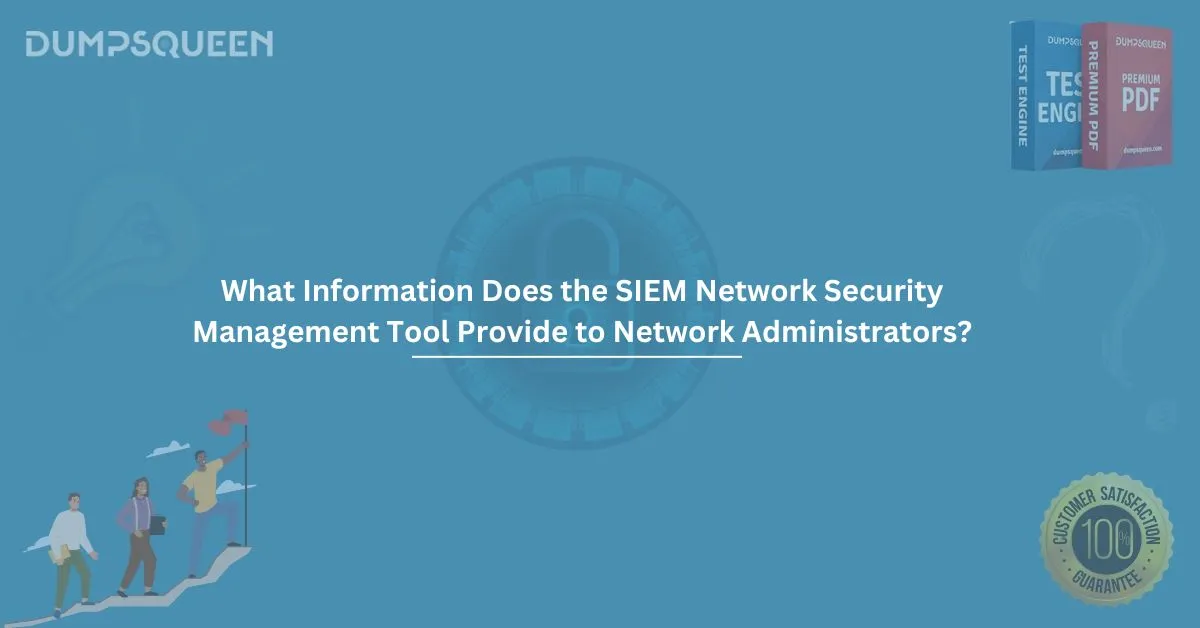In today’s interconnected world, network security is paramount to the smooth operation of any business or organization. Cyber threats are more sophisticated and diverse than ever, requiring robust tools to manage and protect networks. One such tool is the Security Information and Event Management (SIEM) network security management system, which provides network administrators with valuable insights to detect, analyze, and respond to potential security incidents.
The SIEM network security management tool combines security event management (SEM) and security information management (SIM) into one comprehensive platform. This integration helps network administrators centralize their security data, providing real-time visibility into network activities, identifying security threats, and streamlining incident response.
In this blog post, we’ll dive into what information a SIEM tool provides to network administrators and how it enhances overall security management.
1. Centralized Log Management
One of the most important features of SIEM is its ability to collect, aggregate, and store logs from different sources within the network. These sources include firewalls, intrusion detection systems (IDS), antivirus software, and servers. By centralizing logs, network administrators can quickly identify patterns, track user activities, and ensure compliance with regulatory requirements.
The SIEM tool stores logs in a secure database, allowing administrators to easily access them when needed. For instance, logs from a firewall might indicate suspicious activity, such as unauthorized access attempts or an unexpected spike in traffic, while logs from an IDS might reveal patterns consistent with malware activity.
How It Helps Network Administrators
- Streamlined Troubleshooting: Logs allow administrators to quickly diagnose network issues and security incidents.
- Efficient Compliance Management: SIEM tools help organizations meet regulatory requirements by automating log collection and storage.
- Real-time Alerting: If an unusual pattern is detected in the logs, network administrators are alerted immediately.
2. Real-Time Security Alerts and Incident Detection
A major strength of SIEM tools is the ability to detect and alert administrators to potential security threats in real time. The tool continuously analyzes the incoming data, looking for anomalies, suspicious activities, or known attack patterns. For example, a sudden increase in login attempts could indicate a brute-force attack, while an unusual data transfer might suggest data exfiltration.
SIEM tools use predefined rules and advanced analytics to classify events and prioritize them based on their severity. Administrators can customize these rules to better align with the specific needs of their network environment.
How It Helps Network Administrators
- Immediate Threat Detection: SIEM tools provide real-time alerts, enabling administrators to respond quickly.
- Prioritization of Threats: Administrators receive alerts based on the severity of an event, helping them focus on high-risk threats first.
- Automated Threat Response: In some cases, SIEM tools can automatically trigger predefined actions, such as blocking an IP address or isolating a compromised device.
3. Security Incident Correlation and Analysis
SIEM tools correlate data from various network sources to identify relationships between events and potential security incidents. For instance, an attempted login from an unusual IP address, followed by suspicious network activity, may indicate a more significant security breach. SIEM systems use advanced algorithms and correlation rules to automatically identify these patterns and alert administrators.
By correlating data from multiple sources, SIEM tools give network administrators a comprehensive view of the security landscape. This helps prevent false positives, as individual events that might seem insignificant on their own can be placed in context to uncover a larger, coordinated attack.
How It Helps Network Administrators
- Enhanced Threat Detection: By correlating events, SIEM tools provide a deeper understanding of potential threats.
- Reduced False Positives: The correlation process helps reduce the number of irrelevant alerts, allowing administrators to focus on actual security incidents.
- Efficient Incident Response: By linking related events, administrators can more easily determine the scope and impact of an attack.
4. Forensic Data Collection and Investigation
When a security incident occurs, network administrators need the ability to investigate and understand how the attack happened. SIEM tools provide detailed forensic data, including the timeline of events, affected systems, and user activities. This helps administrators reconstruct the sequence of events that led to the security breach and understand how the network was compromised.
Forensic data collection also helps in post-incident analysis, enabling administrators to determine whether any vulnerabilities were exploited, identify gaps in network security, and take corrective actions to prevent future incidents.
How It Helps Network Administrators
- Incident Investigation: SIEM tools provide detailed forensic data to help administrators investigate and understand security incidents.
- Root Cause Analysis: By examining the forensic data, administrators can identify the root cause of an attack and address vulnerabilities.
- Continuous Improvement: Post-incident analysis helps administrators strengthen their security posture and refine detection rules.
5. Compliance Reporting
Compliance with industry regulations and standards such as HIPAA, PCI DSS, and GDPR is critical for many organizations. SIEM tools play an essential role in streamlining compliance by automating the collection, analysis, and reporting of security data. These tools generate compliance reports that detail the organization's adherence to security controls and regulations, helping network administrators demonstrate compliance during audits.
The ability to automatically generate these reports reduces the administrative burden, ensuring that organizations stay compliant without the need for manual intervention.
How It Helps Network Administrators
- Automated Reporting: SIEM tools automate the generation of compliance reports, reducing manual effort.
- Audit Readiness: Administrators can easily access and provide reports for audits, ensuring they meet compliance requirements.
- Risk Management: By analyzing compliance data, administrators can identify and mitigate risks that could affect the organization’s security posture.
6. Threat Intelligence Integration
Some SIEM tools integrate with external threat intelligence feeds, providing administrators with up-to-date information on emerging threats and vulnerabilities. This integration allows administrators to proactively detect new attack techniques and known malicious IP addresses or domains.
By integrating threat intelligence with their internal security data, administrators can gain a better understanding of the evolving threat landscape and respond more effectively to new risks.
How It Helps Network Administrators
- Proactive Threat Detection: Integration with threat intelligence feeds enables administrators to stay ahead of emerging threats.
- Up-to-date Security Information: SIEM tools provide the latest threat data, helping administrators adjust their security measures in real time.
- Increased Incident Response Efficiency: Threat intelligence enhances the SIEM tool’s ability to detect new attack vectors and provide actionable insights.
7. Dashboards and Visualization
The complexity of modern networks and security environments can make it difficult to track security events manually. SIEM tools address this challenge by offering interactive dashboards that provide an intuitive view of security data. These dashboards often feature visual representations of security events, threat levels, and system health.
Network administrators can customize these dashboards to focus on the data that is most relevant to their specific role or network configuration, allowing them to monitor critical metrics and respond to security events more efficiently.
How It Helps Network Administrators
- Real-time Monitoring: Dashboards provide an up-to-date overview of the network’s security status, making it easier for administrators to monitor threats.
- Customizable Views: Administrators can configure dashboards to display the information most relevant to their role.
- Actionable Insights: The visual nature of the dashboards helps administrators quickly identify trends and anomalies that may require attention.
Conclusion
The SIEM network security management tool is an indispensable asset for modern network administrators. It provides comprehensive insights into network activity, helps detect and mitigate security threats, and assists with compliance management. By centralizing logs, analyzing real-time data, correlating events, and offering forensic tools, SIEM tools enable administrators to respond quickly to incidents, reduce risks, and maintain a secure network environment. With its ability to streamline network security operations, a SIEM tool is essential for any organization looking to bolster its cybersecurity defenses.
Sample Questions and Answers
Q1: What is the primary function of a SIEM tool in network security management?
- A) To collect and analyze security logs from various network sources
- B) To prevent all types of cyberattacks
- C) To manage employee passwords
- D) To monitor email security only
Answer: A) To collect and analyze security logs from various network sources
Q2: How does a SIEM tool help with incident detection?
- A) By tracking employee performance
- B) By analyzing security events in real-time and alerting administrators
- C) By blocking unauthorized access to applications
- D) By monitoring social media
Answer: B) By analyzing security events in real-time and alerting administrators
Q3: Which of the following is an advantage of using SIEM tools for compliance reporting?
- A) They automatically generate compliance reports
- B) They eliminate the need for security audits
- C) They prevent all regulatory breaches
- D) They provide only historical data
Answer: A) They automatically generate compliance reports




